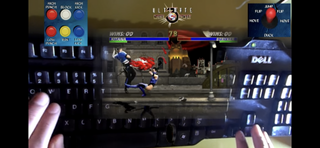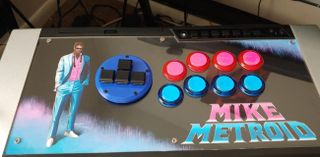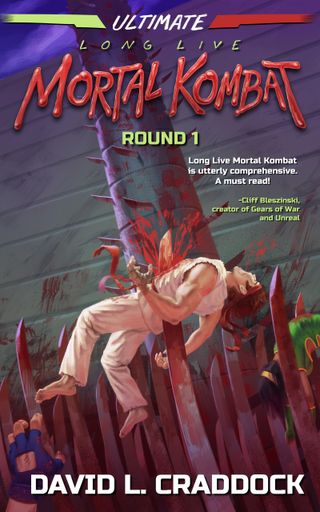Why do Mortal Kombat 3 players still insist on keyboard controls 27 years later?
Learn why Mortal Kombat 3 players swear by mechanical keyboards and more in Long Live Mortal Kombat.

David Craddock, producer on the FPS Documentary and the author of previous video game history books like Dungeon Hacks and the Stay Awhile and Listen series about Blizzard, has launched a Kickstarter for a new series of videogame history books: Long Live Mortal Kombat.
Craddock is compiling interviews with developers who worked on the classic fighting game, as well as with fans and competitive players from various points in the series' lifespan to craft a three-part narrative history of Mortal Kombat. The first volume, The Fatalities and Fandom of the Arcade Era, is dedicated to the games' roots in arcades, as well as the early efforts to bring Mortal Kombat to home consoles and PCs.
In material from the book provided exclusively for PC Gamer, Craddock dives into the development of Mortal Kombat 3's ports, including the PC version, and the difficulties of developing for the gaming hardware wild west of the 1990s.


David Craddock is the author of Long Live Mortal Kombat, as well as books about Diablo, X-COM, and other classic games.
The first excerpt touched on the development of Mortal Kombat 3, firmly at the height of the series' popularity and a time when Midway was striving to produce "arcade perfect" ports of Mortal Kombat for every home console. The differences in hardware were still so vast at this point that the porting effort was outsourced to a specialty studio, Sculptured, that had to specifically craft each iteration of MK3 off Midway's arcade codebase. Sculptured's "crown jewel" of these porting efforts was its DOS and Windows version of Mortal Kombat 3, which lacked the SNES and Genesis' graphical compromises and the PS1's long load times.
It's a bit strange from the perspective of our current era's platform ecosystem, but during the first several decades of gaming history, arcade technology vastly outstripped anything you could have at home.
Craddock also discusses Sculpture's work on MK3's early network multiplayer capabilities, the surprising developer behind them, as well as a quirk in its netcode that could bring an entire office's internet to its knees:
Peters credits Oren Peli with MK3's networking code. Peli, who went on to write and direct the horror film Paranormal Activity, programmed MK3's multiplayer mode to search for players over a LAN. The problem was the game pinged—sent out a signal letting other computers know it was interested—constantly. "Anyone in your company who did the same thing, those games were sitting there, broadcasting on your network," Peters says. "The more people who booted it up, the more noise and traffic you had on your network from these workstations saying, 'I'm here, let's play.'"
The biggest gaming news, reviews and hardware deals
Keep up to date with the most important stories and the best deals, as picked by the PC Gamer team.
Craddock's excerpts also touch on another topic that may seem foreign to today's PC gamers: the variety and unreliability of PC hardware configurations in the '90s:
One of the biggest issues with PC gaming until the mid-2000s was the lack of standardization in hardware. There were so many processors, sound cards, graphics chips, display modes, and controllers that a developer's decision to support one or another meant you either got the best version of an arcade game, or one that was barely playable, if it ran at all.
Sculptured also ran into similar trouble designing PC controls for Mortal Kombat 3. Even our ubiquitous mouse and keyboard controls had yet to be set in stone at this time, and the xinput gamepads we take for granted today didn't come on the scene until the Xbox 360's release in 2005. Until then, PC controllers ran the gamut of size and quality, with none of them being a great fit for Mortal Kombat. Craddock writes:
Most controllers for PC had two buttons, making them inadequate for games like MK3 and Super Street Fighter II. Joysticks were more common because of the popularity of flight simulators, but joystick button layouts were designed for those types of games. The Gravis Gamepad, one of the most popular controllers during the '90s, had four buttons, still shy of what MK and Street Fighter titles required.
But there was a perfect option right under Sculptured's nose: the humble keyboard, sans mouse. It makes sense: keyboards have more than enough buttons to cover the combo and movement options needed, and the ability to remap and customize layouts offers a similar advantage here as in more familiar PC genres like first person shooters or real time strategy games. What's more, the widespread adoption of mechanical keyboards and their attendant input advantages has led to them becoming a sleeper favorite for playing Mortal Kombat 3 to this day. Craddock went in-depth on this aspect of the community in the second excerpt:
The strongest benefit to playing on a keyboard, particularly mechanical models, is how they read keypresses… Mechanical keyboards, many of which are tailored for gaming, cost more to build and more to purchase, but their makers take no shortcuts. Each key has its own circuit, and you can press as many as you like at once.
That quality of mechanical keyboards' input allows players to easily "buffer" moves, setting up combos and overwhelming opponents. Craddock highlights several currently-active Mortal Kombat 3 players who utilize keyboard controls instead of or in addition to fight sticks, including Kano Kriminal, Andrey Stefanov, and Mgo Umk, whose MK3 gameplay videos often include an overhead view of his hands at the keyboard, showing off this unique gameplay style. Seeing the playstyle in action is reminiscent of high-level fight stick gameplay: the layouts are similar, and Mgo Umk even directly compares their keyboard button mapping to an arcade board's layout.
Sculptured's attention to MK3's keyboard controls may have been even more far-sighted than the competitive community's persistent love indicates. The 2015 fighting game project, Rising Thunder, focused on keyboard controls and had a lot of potential as an approachable, free-to-play fighting game. Radiant Entertainment was later acquired by Riot Games in 2016 and has been co-developing the League of Legends fighting game currently known as Project L. Rising Thunder's keyboard-centric gameplay could form a foundation for that experience and also help introduce MOBA fans to the genre.
In just 12 sample pages of the first volume of Long Live Mortal Kombat, Craddock provides an enticing snapshot of a lost moment in gaming, as well as a fascinating look at how a development decision like Sculptured's attention to MK3's keyboard controls can reverberate through the years.
It's a level of attention and care that the history of the hobby deserves, reminiscent of great work on development and enthusiast stories of years past by the Gaming Historian or Digital Foundry Retro. The full package of Long Live Mortal Kombat promises to be something special. The project's Kickstarter campaign is open for backers.

Ted has been thinking about PC games and bothering anyone who would listen with his thoughts on them ever since he booted up his sister's copy of Neverwinter Nights on the family computer. He is obsessed with all things CRPG and CRPG-adjacent, but has also covered esports, modding, and rare game collecting. When he's not playing or writing about games, you can find Ted lifting weights on his back porch.
Most Popular





